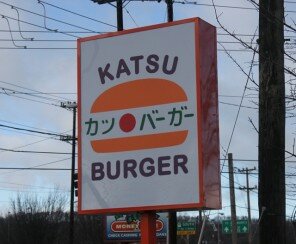 Paseo, Salumi and many Vietnamese delis selling BBQ pork banh mi: All are superb places for a sandwich in Seattle. Now it’s time to add Katsu Burger to that elite list. Hajime Sato, (sustainable) sushi chef at Mashiko, recently opened this bustling eatery in Georgetown, and I’ve already heard rumors of expansion, perhaps to South Lake Union.
Paseo, Salumi and many Vietnamese delis selling BBQ pork banh mi: All are superb places for a sandwich in Seattle. Now it’s time to add Katsu Burger to that elite list. Hajime Sato, (sustainable) sushi chef at Mashiko, recently opened this bustling eatery in Georgetown, and I’ve already heard rumors of expansion, perhaps to South Lake Union.
Sato’s burgers are based on tonkatsu, a panko-breaded, deep-fried pork cutlet typically served with shredded cabbage, rice, miso soup, and some Japanese pickles. Both the pork and the cabbage are delicious with a squiggle of sweet and tangy tonkatsu sauce, though I also like my pork with some karashi. (Karashi is spicy Japanese mustard, which I think would be a killer ingredient if introduced to Katsu’s burgers.)
Katsu Burger offers a choice of deep-fried meats for their burgers. While beef and chicken (there’s also tofu) are options, pork is classic for katsu, so I’m a bit surprised that the first, basic burger on the menu is beef—and is called Tokyo Classic. It’s simply the patty with Japanese mayonnaise and tonkatsu sauce on the bun ($6.95), topped (like all the burgers) with shredded cabbage, tomatoes, red onions, and pickles. The menu says meat substitutions are fine, but a newbie might not realize this. In the future, I’ll go with a pork version of the Tokyo Classic—it’s what I recommend to others—but first visit, I got these:
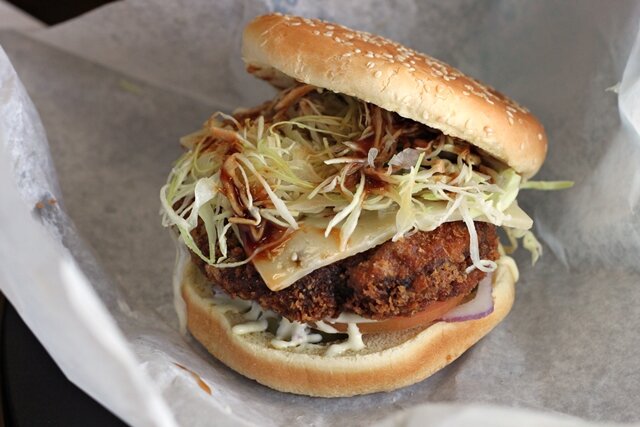 Wabi Wasabi (beef patty, pepper jack, wasabi mayonnaise, and tonkatsu sauce, $7.55)
Wabi Wasabi (beef patty, pepper jack, wasabi mayonnaise, and tonkatsu sauce, $7.55)
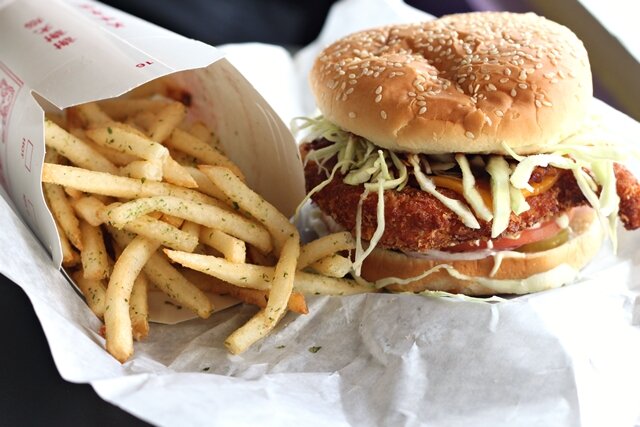 Ninja Deluxe (pork cutlet, cheddar, bacon, Japanese mayonnaise, and tonkatsu sauce, $8.25)
Ninja Deluxe (pork cutlet, cheddar, bacon, Japanese mayonnaise, and tonkatsu sauce, $8.25)
The beef, batter-fried with juices sealed in, was fun to try, but I much preferred the pork. “We use natural pork loin (no added growth hormones or antibiotics), which is more expensive but definitely worth it,” Sato explained, adding, “We brine and season it to make it tender and tasty.”
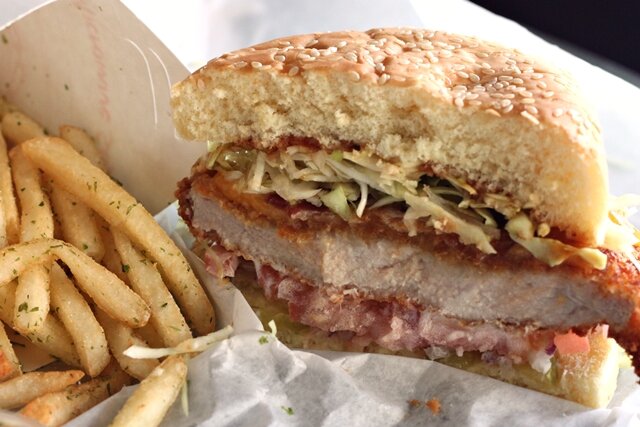 Tender and tasty indeed. Pounding the pork contributed to this, and also made the katsu burger quite sexy.
Tender and tasty indeed. Pounding the pork contributed to this, and also made the katsu burger quite sexy.
Should you be unable to choose between meats, you can climb all the way up to a Mt. Fuji, featuring a beef patty, pork cutlet, and chicken breast along with ham, bacon, two cheeses, and other fixings ($16.25). There are also choices of sides for the burgers, which you can combine to make meal deals. An Ichi-ban (+$3.15) gets you seasoned fries (either curry or nori-seasoned), one dipping sauce, and a regular drink—which can be upgraded to a shake (+$2.50). I recommend the nori fries and a green tea milkshake for an amazing East-meets-West fast food meal that’s actually made to order.
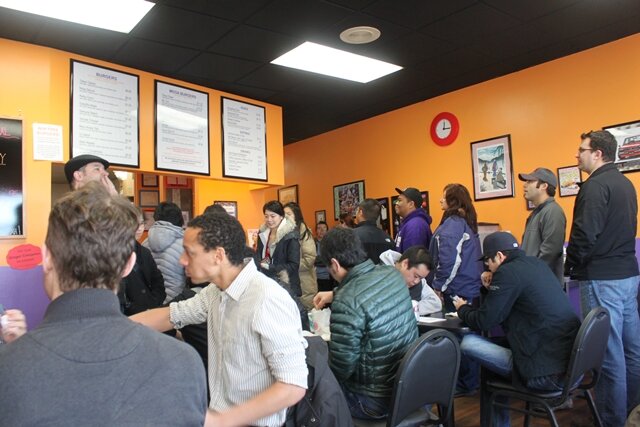 If you’re really hungry, you can opt for a Ni-ban meal (+$5.15), which adds a side of wasabi coleslaw to your Ichi-ban order. And if you want to go really crazy, you can “Sumo size it!” with Banzai bites (six chicken “tenders”), fries, cole slaw, slaw, two dipping sauces, and a regular drink for an additional $7.95, which likely exceeds the cost of your burger. Now you’re eating like a real American.
If you’re really hungry, you can opt for a Ni-ban meal (+$5.15), which adds a side of wasabi coleslaw to your Ichi-ban order. And if you want to go really crazy, you can “Sumo size it!” with Banzai bites (six chicken “tenders”), fries, cole slaw, slaw, two dipping sauces, and a regular drink for an additional $7.95, which likely exceeds the cost of your burger. Now you’re eating like a real American.
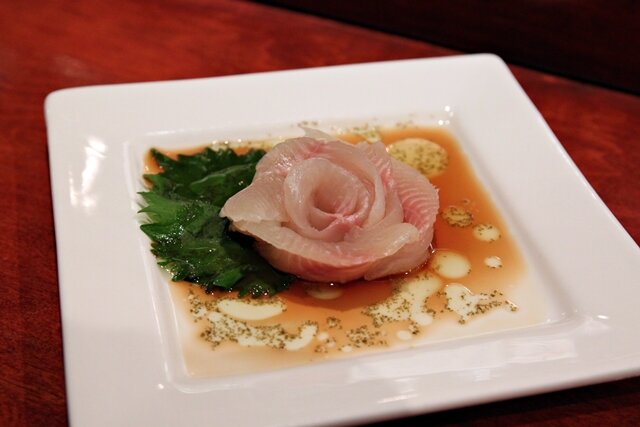
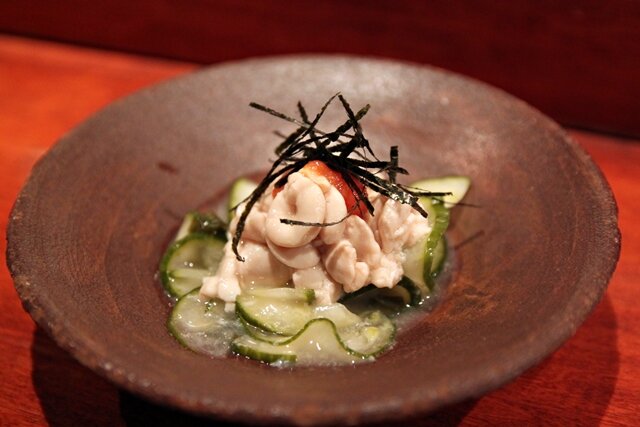
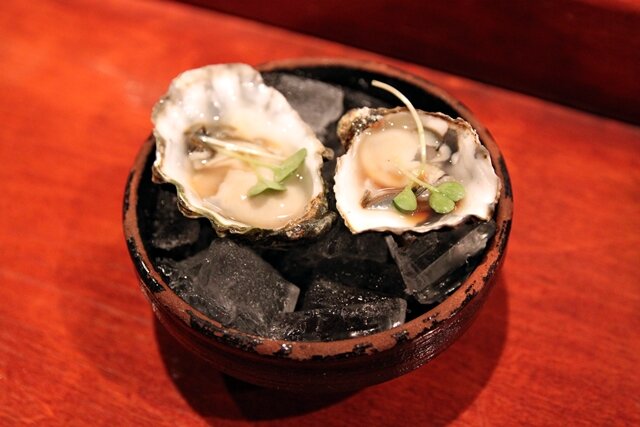

















 Paseo, Salumi and many Vietnamese delis selling BBQ pork banh mi: All are superb places for a sandwich in Seattle. Now it’s time to add Katsu Burger to that elite list. Hajime Sato, (sustainable) sushi chef at Mashiko, recently opened this bustling eatery in Georgetown, and I’ve already heard rumors of expansion, perhaps to South Lake Union.
Paseo, Salumi and many Vietnamese delis selling BBQ pork banh mi: All are superb places for a sandwich in Seattle. Now it’s time to add Katsu Burger to that elite list. Hajime Sato, (sustainable) sushi chef at Mashiko, recently opened this bustling eatery in Georgetown, and I’ve already heard rumors of expansion, perhaps to South Lake Union.

